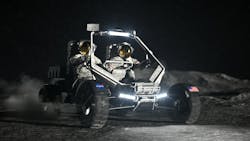-
NASA selected three scientific instruments - two for the Lunar Terrain Vehicle (LTV) and one for a future orbital mission - to support its Artemis program’s exploration of the Moon’s south polar region.
-
The AVIRIS-Classic and new AVIRIS-5 imaging spectrometers will analyze minerals, volatiles, and subsurface structures to support astronaut operations and map lunar resources.
-
NASA is reviewing lunar vehicle designs from Intuitive Machines, Lunar Outpost, and Venturi Astrolab, with a final selection expected by the end of 2025.
WASHINGTON- The National Aeronautics and Space Administration (NASA) has chosen three new scientific instruments to support its Artemis lunar exploration program, including two slated for deployment on the agency’s next-generation Lunar Terrain Vehicle (LTV) and one for a future orbital mission.
The instruments will help advance NASA’s understanding of the Moon’s surface and subsurface composition, as well as support safe and effective astronaut operations. The LTV, the first crew-driven vehicle to operate on the Moon in more than five decades, is designed to carry up to two astronauts or operate remotely to explore broad areas of lunar terrain.
"The Artemis Lunar Terrain Vehicle will transport humanity farther than ever before across the lunar frontier on an epic journey of scientific exploration and discovery," said Nicky Fox, associate administrator for NASA’s Science Mission Directorate.
NASA seeks industry support for aerocapture demo mission in Earth orbit
Lunar mapping
One instrument, the Artemis Infrared Reflectance and Emission Spectrometer (AIRES), will map lunar minerals and volatiles in the Moon’s south polar region. Another, the Lunar Microwave Active-Passive Spectrometer (L-MAPS), combines ground-penetrating radar and spectroscopy to search for subsurface ice and measure temperature and density to depths exceeding 130 feet.
NASA also selected the Ultra-Compact Imaging Spectrometer for the Moon (UCIS-Moon) for a future orbital flight. This instrument will provide high-resolution imaging of surface water, mineral composition, and the impact of human activity on the Moon’s volatile materials.
"These three scientific instruments will make significant progress in answering key questions about what minerals and volatiles are present on and under the surface of the Moon," said Joel Kearns, deputy associate administrator for exploration at NASA.
NASA is currently reviewing design proposals from three commercial LTV vendors - Intuitive Machines of Houston, Lunar Outpost of Golden, Colo., and Venturi Astrolab of Hawthorne, Calif. A final decision on the demonstration mission is expected by the end of 2025.
The Artemis program aims to enable sustained lunar exploration and prepare for eventual crewed missions to Mars by combining robotic and human capabilities to study Earth’s natural satellite.
About the Author
Jamie Whitney
Senior Editor
Jamie Whitney joined the staff of Military & Aerospace Electronics in 2018 and oversees editorial content and produces news and features for Military & Aerospace Electronics, attends industry events, produces Webcasts, and oversees print production of Military & Aerospace Electronics.
